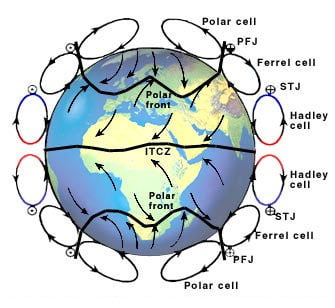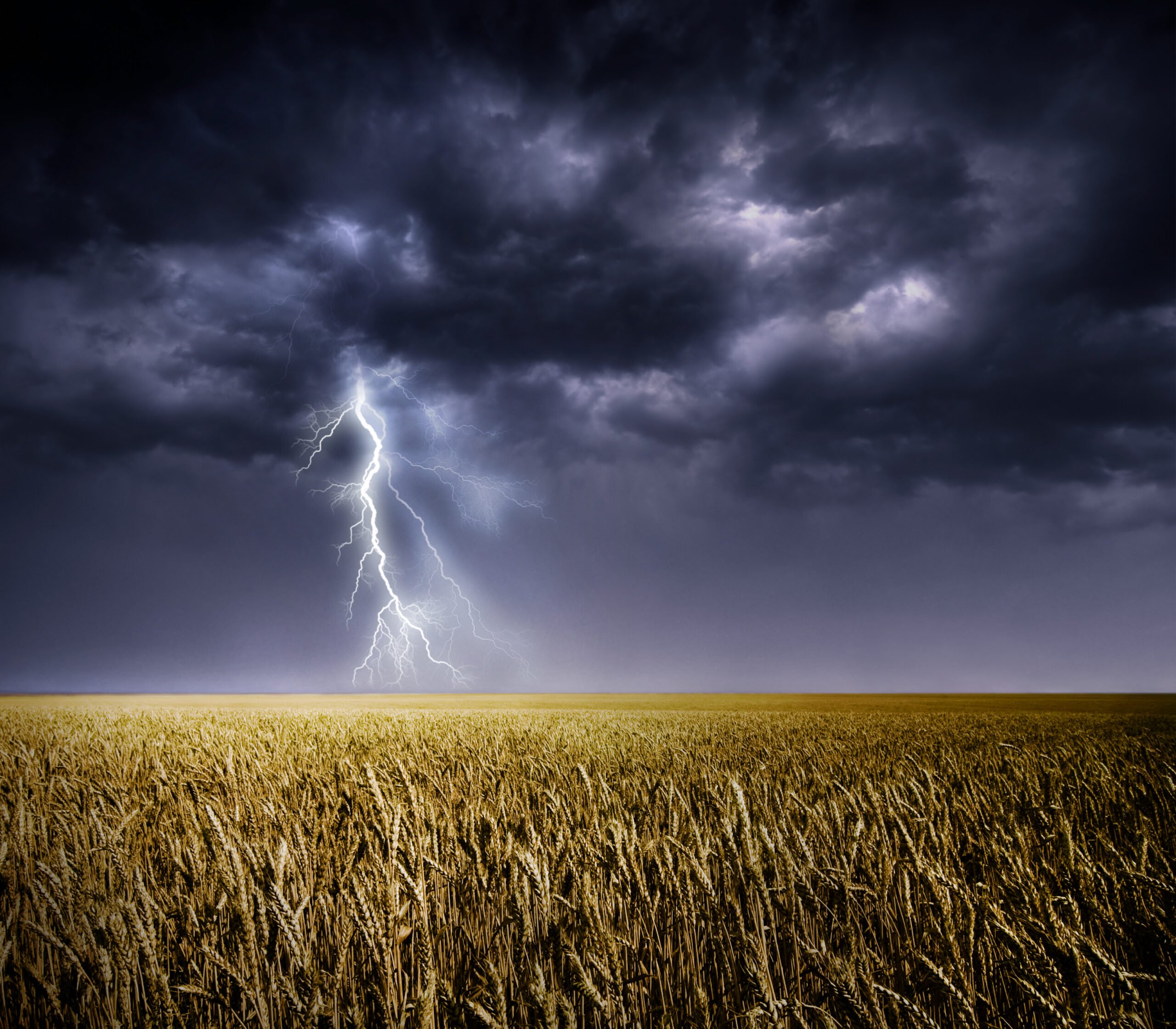Questions to consider:
To what extent can all climate change be seen as a tipping point?

Map of potential tipping elements in the climate system, overlain on global population density. The subsystems indicated, including the cryosphere, the circulation of the atmospheres and oceans and biomes, could exhibit threshold-type behaviour in response to anthropogenic climate forcing, where a small perturbation at a critical point qualitatively alters the future fate of the system. They could be triggered this century and would undergo a qualitative change within this millennium. Systems in which any threshold appears inaccessible this century (e.g., East Antarctic Ice Sheet) or the qualitative change would appear beyond this millennium (e.g., marine methane hydrates) have not been included. Question marks indicate systems whose status as tipping elements are particularly uncertain.
Summary:
- A climate tipping point is a critical threshold when global or regional climate changes from one stable state to another stable state. The tipping point event may or may not be reversible.
- Aspects of the Earth’s climate system have tipped in the past, and projections suggest that increasing greenhouse gas concentrations may lead to future tipping points being reached.
- The most likely abrupt, but reversible, change to the climate system expected in the 21st century is the decline of Arctic sea-ice, especially in the summer.
Case Studies
Summer Arctic Sea Ice
An Amazon Basin Tipping Point
Further Information
Abrupt climate change is defined as a large scale change in the climate system which takes place over a few decades or less and is anticipated to persist for at least a few decades, and causes substantial disruption in human and natural systems. A number of components or phenomena within the Earth’s climate system have been proposed as potentially possessing critical thresholds, referred to as tipping points, beyond which abrupt or nonlinear transitions to a different state ensues. Such a change is irreversible if the recovery time scale due to natural processes is significantly longer than the time it took to reach the new state. So, to some extent, it can be said that most aspects of climate change due to CO2 emissions are irreversible due to the long residence time of CO2 in the atmosphere.

Greenland and West Antarctic Ice Sheets – Like sea-ice, ice sheets have a high albedo, locally reflecting much of the Sun’s energy. They are much thicker than sea-ice though, being up to several kilometres thick and penetrating into the colder, higher atmosphere. As ice sheets melt at their edges, their albedo is reduced, but they can also get thinner. The Greenland Ice Sheet is thinning and as it thins its surface lowers, sinking to warmer temperatures at lower altitudes. In West Antarctica, the ice sheet is largely resting on rock below sea level. Ocean water is able to melt floating ice but also undercut ice sheets, forcing more ice to float and therefore melt. Palaeo-records show that both the Greenland and West Antarctic Ice Sheets have melted and collapsed in the past, indicating they are probably susceptible to tipping points.
Atlantic Deep Water formation – Cold, salty, deep water is produced in the North Atlantic, partly driving the global ocean circulation. However, when ice sheets (such as the Greenland Ice Sheet) melt, they release freshwater into the Atlantic. An input of freshwater makes the ocean less salty and less dense, reducing the amount of deep water produced and slowing down the ocean circulation. As ice sheets melt, deep water formation and ocean circulation are probably vulnerable to a critical tipping point as well.
El Niño Southern Oscillation (ENSO) – The periodic change in sea surface temperatures in the tropical Pacific, known as ENSO, has an impact on temperatures and precipitation in the neighbouring contents and across the globe. Both the duration and strength of the warmer (El Niño) and colder (La Niña) parts of the oscillation vary considerably, but current projections suggest that extreme ENSO events may become more frequent. However, it is not yet certain when a threshold might be reached, or whether this tipping point would be gradual or rapid.
Monsoons – Any changes in the atmospheric circulation which lead to changes in the land-ocean pressure gradient could affect the monsoon. Palaeo-records indicate that both the Indian Summer Monsoon and West African Monsoon have shifted in the past, causing large changes in rainfall and vegetation. It is possible that changes to the West African monsoon could lead to greening of the Sahara/Sahel; a rare example of a beneficial potential tipping point.
Amazon Rainforest – Rainfall in the Amazon Basin is largely recycled from moisture within the rainforest. A tipping point could arise where a certain amount of dieback stops the effective recycling of precipitation to the rest of the rainforest, resulting in more rapid dieback. An Amazon Basin Tipping Point
Boreal – Tundra Biome shift – Boreal – Tundra Biome Shift
There is plenty of evidence of past climate change which was abrupt on timescales of 10-100 years through the last glacial cycle and beyond. This includes Dansgaard-Oeschger events marked by rapid Greenland warming and triggered by iceberg/ meltwater discharges associated with Heinrich events. It cannot yet be said whether these Heinrich events were triggered by changes in atmospheric or oceanic circulation, internal ice sheet dynamics or even by changes in the Sun’s activity. They caused changes to global precipitation and temperature patterns.
Further Links:
There is a nice diagram illustrating the positive feedback mechanisms that can lead to abrupt climate change at http://www.climateemergencyinstitute.com/uploads/six_large_feedbacks.png
Could Rapid Release of Methane and Carbon Dioxide from Thawing Permafrost or Ocean Warming Substantially Increase Warming?
WG1 FAQ 6.1
Permafrost is permanently frozen ground, mainly found in the high latitudes of the Arctic. Permafrost, including the sub-sea permafrost on the shallow shelves of the Arctic Ocean, contains old organic carbon deposits. Some are relicts from the last glaciation, and hold at least twice the amount of carbon currently present in the atmosphere as carbon dioxide (CO2). Should a sizeable fraction of this carbon be released as methane (CH4) and CO2, it would increase atmospheric concentrations, which would lead to higher atmospheric temperatures. That in turn would cause yet more methane and CO2 to be released, creating a positive feedback, which would further amplify global warming.
The Arctic domain presently represents a net sink of CO2—sequestering around 0.4 ± 0.4 PgC/ yr in growing vegetation representing about 10% of the current global land sink. It is also a modest source of methane (CH4): between 15 and 50 Tg(CH4)/ yr are emitted mostly from seasonally unfrozen wetlands corresponding to about 10% of the global wetland methane source. There is no clear evidence yet that thawing contributes significantly to the current global budgets of these two greenhouse gases. However, under sustained Arctic warming, modelling studies and expert judgments indicate with medium agreement that a potential combined release totalling up to 350 PgC as CO2 equivalent could occur by the year 2100.
Permafrost soils on land, and in ocean shelves, contain large pools of organic carbon, which must be thawed and decomposed by microbes before it can be released—mostly as CO2. Where oxygen is limited, as in waterlogged soils, some microbes also produce methane.
On land, permafrost is overlain by a surface ‘active layer’, which thaws during summer and forms part of the tundra ecosystem. If spring and summer temperatures become warmer on average, the active layer will thicken, making more organic carbon available for microbial decomposition. However, warmer summers would also result in greater uptake of carbon dioxide by Arctic vegetation through photosynthesis. That means the net Arctic carbon balance is a delicate one between enhanced uptake and enhanced release of carbon.
Hydrological conditions during the summer thaw are also important. The melting of bodies of excess ground ice may create standing water conditions in pools and lakes, where lack of oxygen will induce methane production. The complexity of Arctic landscapes under climate warming means we have low confidence in which of these different processes might dominate on a regional scale. Heat diffusion and permafrost melting takes time—in fact, the deeper Arctic permafrost can be seen as a relic of the last glaciation, which is still slowly eroding—so any significant loss of permafrost soil carbon will happen over long time scales.
Given enough oxygen, decomposition of organic matter in soil is accompanied by the release of heat by microbes (similar to compost), which, during summer, might stimulate further permafrost thaw. Depending on carbon and ice content of the permafrost, and the hydrological regime, this mechanism could, under warming, trigger relatively fast local permafrost degradation.
 As the atmosphere and oceans warm, sea-ice melts which exposes a much darker ocean. This triggers a positive feedback by lowering the albedo of the ocean’s surface and leading to more of the Sun’s light being absorbed, amplifying the warming.
As the atmosphere and oceans warm, sea-ice melts which exposes a much darker ocean. This triggers a positive feedback by lowering the albedo of the ocean’s surface and leading to more of the Sun’s light being absorbed, amplifying the warming.
The rapidly declining summer Arctic sea-ice cover might already have passed a tipping point, although this is hard to identify due to high year-to-year variability. In this case, the Arctic will change from having year round to seasonal sea-ice cover.
It is likely that the Arctic Ocean will become nearly ice-free in September before 2050. The transition will be abrupt but, if the amount of CO2 in the atmosphere falls, the loss of sea-ice could be reversed within years to decades.
The effect of rapid changes to Arctic sea-ice might have consequences throughout the climate system, particularly on cloud cover.







